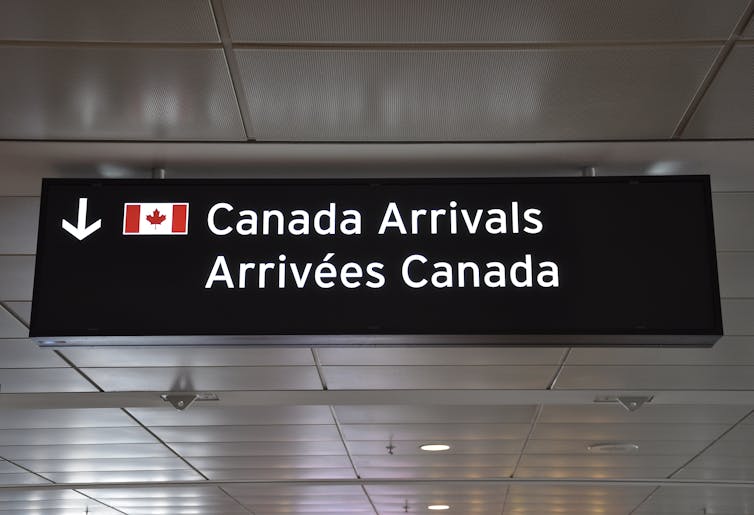
Canada’s population has officially surpassed 40 million people, and immigration has significantly contributed to reaching this milestone. In 2021, immigrants made up almost one-quarter of the Canadian population.
Globally, Canadians are viewed as very welcoming of immigrants. In 2019, the country placed first in Gallup’s Migration Acceptance Index. Canada has a dynamic immigration system that is celebrated as a model for other countries.
Its immigration system responds to the country’s economic needs, with immigration contributing to almost 100 per cent of Canada’s labour force growth. It is also recognized as a world leader in refugee resettlement. This includes a large private sponsorship program in which groups of Canadians can sponsor refugees.
Immigrants face challenges
Despite receiving international praise, Canada’s immigration system is not without criticism. Immigrants often face challenges, including barriers to finding jobs that make use of their skills and qualifications. Research also suggests immigrants face discrimination in a variety of domains, such as when accessing housing, education and health care.
Canada is in the midst of the largest intake of immigrants in its history as the government looks to rebuild the economy and labour force following the COVID-19 pandemic.

The federal government has announced plans to admit 465,000 permanent residents in 2023, 485,000 in 2024, and 500,000 in 2025.
At this critical time, the success of Canada’s immigration program depends on actively welcoming immigrants and supporting their settlement and integration into communities of all sizes.
In this context, now is the time to ask: How can Canada create more welcoming communities for immigrants?
What makes a community welcoming for immigrants?
We define a welcoming community as a joint effort by all members of a community to design and maintain a place where immigrants feel they belong. It is a place that supports immigrants’ economic, social, cultural, civic and political integration.
A welcoming community has structures and practices in place to meet the needs and promote the inclusion of immigrants in all aspects of life. It must routinely measure and evaluate these initiatives to ensure their effectiveness.
In our recent work with the Pathways to Prosperity Partnership, we identify and explain the key characteristics of welcoming communities.
To determine these characteristics, we polled 259 immigration experts from the government, the settlement sector and academia. We identified 19 key characteristics of welcoming communities and placed them in order of importance based on input from respondents.
These five characteristics were deemed most important:
Access to affordable, adequate and suitable housing
Employment and entrepreneurship opportunities
Access to suitable health care, including mental health care
Positive attitudes towards immigrants of all racial, cultural, and religious backgrounds
Access to immigrant-serving agencies that meet immigrants’ needs
Characteristics that make communities welcoming do not operate alone. They interact and reinforce each other. For example, the location of affordable housing affects access to immigrant-serving agencies and employment opportunities. Likewise, employment and entrepreneurship opportunities affect whether immigrants can afford suitable housing.
It is also critical for communities to consider the barriers faced by immigrants who are racialized, women, refugees, 2SLGBTQI+, people with disabilities, youth, seniors and those who have experienced trauma.
How to measure the characteristics that make a community welcoming

We created a set of indicators for each of the characteristics of a welcoming community. Communities can use these indicators to evaluate how well they perform on each characteristic. They can also use these indicators to determine whether strategies they implement to be more welcoming are effective.
One of the key characteristics of a welcoming community is employment and entrepreneurship opportunities. An important indicator here is the rate of employment among working-age immigrants.
Communities must make meaningful comparisons (whether across time, with other communities or to non-immigrants) in order to interpret each indicator. For example, how do immigrants’ employment rates compare to those of non-immigrants?
Communities must also make an effort to understand what accounts for the current indicator levels within their community. For example, employment opportunities for immigrants will be more readily available at times of low unemployment rates, as is currently the case.
Communities in Canada cannot be complacent about how they welcome newcomers. Policymakers at all levels of government, service providers and the general public all have an important role to play.
There are many ways people can make their communities more welcoming. One key way to start is by learning how Canada’s immigration system works.
There are also lots of opportunities to volunteer with an immigrant-serving agency near you. You can even join a formal program that matches longtime community members with newcomers.
Together we can translate positive attitudes into positive action to create and maintain fully welcoming communities. Actively engaging in actions to make communities more welcoming is critical to the success of Canada’s immigration program.
Leah Hamilton receives funding from the Social Sciences and Humanities Research Council of Canada.
Awish Aslam has previously been funded by the Social Sciences and Humanities Research Council of Canada.
Victoria Esses receives funding from Immigration, Refugees and Citizenship Canada, and has previously been funded by the Social Sciences and Humanities Research Council of Canada.
Priscila Ribeiro Prado Barros does not work for, consult, own shares in or receive funding from any company or organisation that would benefit from this article, and has disclosed no relevant affiliations beyond their academic appointment.
This article was originally published on The Conversation. Read the original article.







